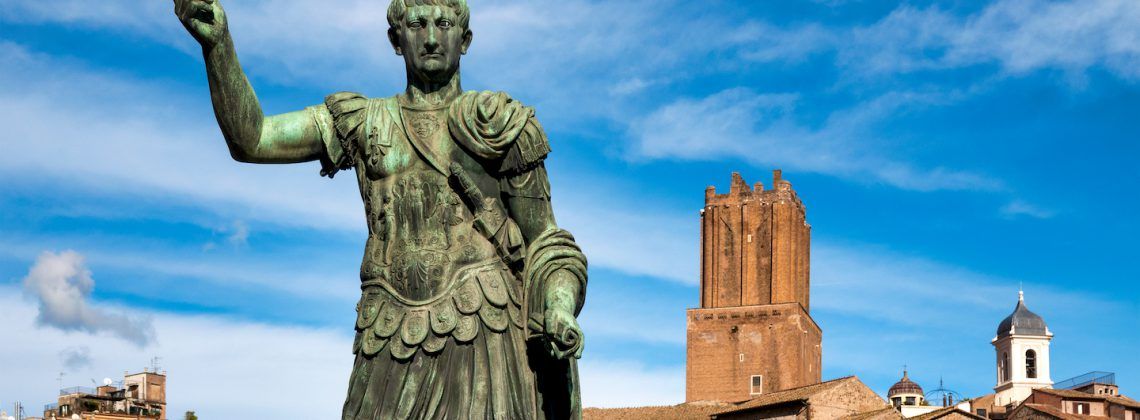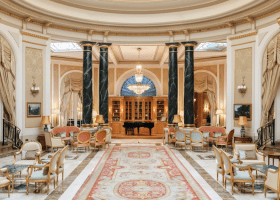Ancient Rome housed numerous emperors that left imprints in the city we visit nowadays. On one hand, some of these emperors received love admiration by their contemporaries. On other hand, some other emperors had bad fame that sources and historians have portrayed. Among the many emperors Rome had throughout its history… historians know five of them as ‘the Five Good Emperors’. Here is why these five leaders carved their names in history!
Good or Bad Emperors?
Do we know for sure if an emperor was good or bad? The legacy of each Emperor is told by who came after them and leaves much to be interpreted. Our current views on emperors, as historian Mary Beard points out, are the result of the views of ancient writers and modern historians.
Roman writer Tacitus mentions that after the Great Fire of Rome in AD 64 Nero carried out relief works, distributed food, and created shelter for refugees. The stories we know about Nero speak of him playing the fiddle as Rome fell to ashes. That said, the public works he built after the great fire would put him in the ranks of Rome’s best civil engineer.
We can live inside the two extreme views of each emperor or consider a point made by history Mary Beard. Suetonius and other ancient writers described these emperors’ personalities and qualities as individuals. These descriptions written in history books are what we know of these Emperors and how they earned their title of good or bad.
That said, their general behavior did not matter very much to the inhabitants of the Roman empire, to the mechanisms of Rome itself, and everything that happened in the Roman world. The people either knew property or depression, wealth of famine, and good times or bad.
We have inherited stories of the emperor’s lives, produced in a specific context and time, by writers who had certain interests and were biased by their own circumstances or interactions with that emperors. These narratives, written with self-interest in mind, have shaped our understanding of Ancient Rome.
This may or may not be the case with the Five Good Emperors, but their legacy is remembered as overall positive. This is who they are and possibly how they achieved greatness.
The Five Good Emperors
The end of the 1st century AD witnessed substantial changes in Rome. A new phase in the Empire commenced known among historians as the period of The Five Good Emperors.
These emperors are Nerva, Trajan, Hadrian, Antoninus Pius, and Marcus Aurelius. Traditionally, historians have considered the period of time comprised between AD 96 – AD 180 as one of the peaks of Roman history.
Rome saw prosperity, stability, and expansion. Many historians attribute this long-term success and prosperity to how each emperor named his heir. Instead of choosing a biological son or kin, these emperors adopted the best candidate to succeed them.
Edward Gibbon is the first author who identified and described these five good emperors in 1776 in his work The Decline and Fall of the Roman Empire. In Chapter Three, he affirmed:
“If a man were called to fix the period in the history of the world during which the condition of the human race was most happy and prosperous, he would, without hesitation, name that which elapsed from the death of Domitian to the accession of Commodus”.
The impact of his work and his judgment of their reigns permeated history and shaped, as Mary Beard noted, our views on these emperors. Recently, the weaknesses of this period, such as the extreme centralization of power in the hands of the emperor, have been recognized. Despite this, historiography has labeled these emperors as the five good ones, and it is worth knowing a little bit more about their lives and major works.
Let’s get to know them!
1. NERVA, the Senate’s Emperor
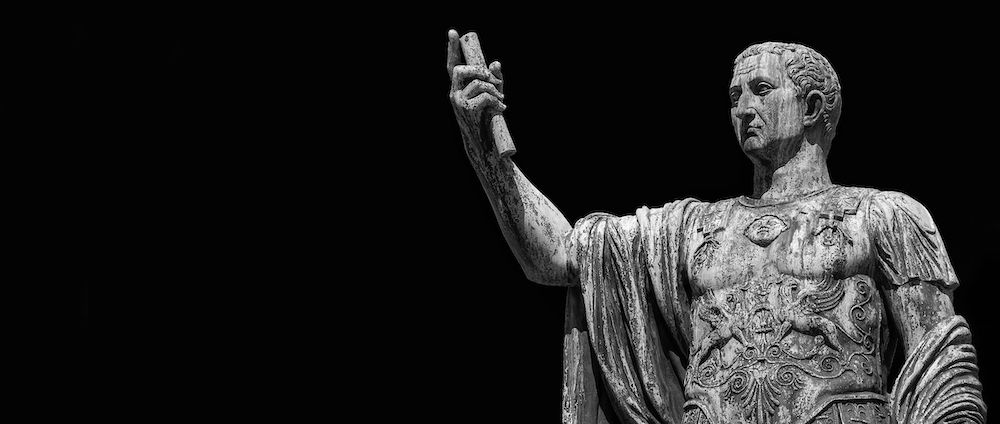
AD 96 | Foro Transitorio | Senate
Life: AD 30 – AD 98. Emperor: AD 96 – AD 98
Nerva is well-known for the brevity of its reign, which started in September AD 96 and it lasted only 16 months. He died in AD 98 of natural causes and he is known to be the first of “the 5 Good Emperors”. Despite encountering difficulties after Domitian’s reign, Nerva brought some stability to the Empire. That’s why historians consider his reign an interlude between the emperors Domitian and Trajan.
Prior to becoming emperor, Nerva was a senator and an important member of the imperial court. Although the Senate appointed him as emperor, Nathan T. Elkins notes how he was also a favorite to other factions such as civilians and the military.
During his brief reign, he undertook many social and tax reforms, which were later on continued by Trajan. One of the challenges he encountered was the military unrest following Domitian’s assassination. In this regard, Pliny even mentioned that tensions with the military led him to adopt Trajan as his successor.
Major Works
Unlike many other emperors, the brevity of his reign did not allow Nerva to build and commission monumental projects to transmit his power. However, we still have the remains of some of the projects he undertook. For example, in the imperial forum, he continued the forum that Domitian had begun and renamed it.
In reality, he basically inaugurated the monumental public square in AD 97, since it was Domitian who had carried out the major works. This forum housed a temple dedicated to Minerva. In addition, some inscriptions testify that Nerva also built a granary and carried out some redevelopments in the Colosseum.
Finally, Nerva is famous for appointing Frontinus as Rome’s water commissioner, who instituted several water reforms and construction work described in his work on aqueducts.
2. TRAJAN, the “Optimus Princeps”
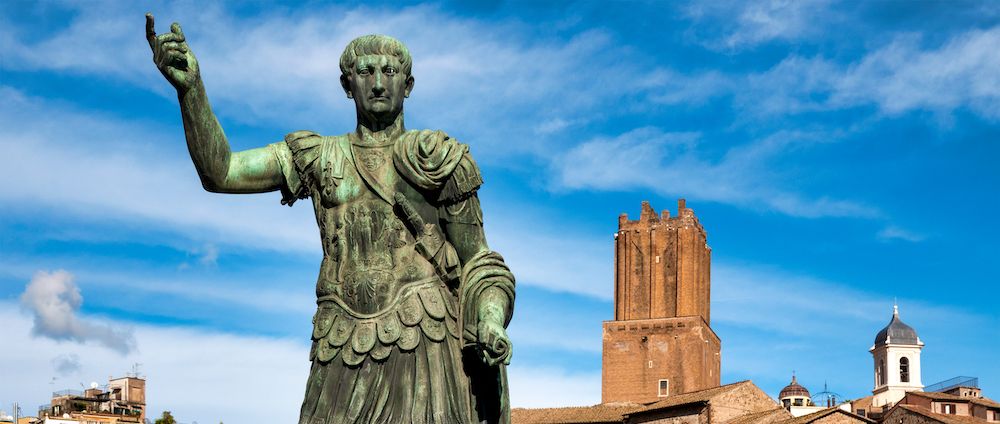
Trajan’s Column | Dacia | Trajan’s Forum
Life: AD 53-117. Emperor: AD 98-117
Trajan is famous for the popularity he gained among the Romans, and during the Middle Age. He became emperor in AD 98, after Nerva’s death. During his reign, he carried out military conquest to the east of the Empire, annexing territories in Dacia (Romania), Arabia, and Armenia, among others.
Archeologist Amanda Claridge refers to how the military glory and wealth he brought to Rome after his campaigns are reflected in his urban projects (improvements). Trajan died in AD 117 when he was returning from military campaigns against the Parthians.
Such was his popularity among the Romans, that emperors such as Septimius Severus added to his official literature that he was Trajan’s great-great-grandson and speaks of Trajan’s victory over the Parthians, as historian Julian Bennett mentions.
Certainly, Trajan is known to be an exemplar emperor who, despite being pagan, he was admired by Christians in the Middle Age. For instance, St. Gregory the Great interceded and prayed for his salvation because of the good service he had provided to people during his reign.
In addition, Trajan’s appearance in Dante’s Divine Comedy contributed to the increase of his popularity into the Middle Ages, Renaissance, and Modernity. His nickname, Optimus Princeps, translates to the Best Ruler.
Major Works
In AD 112 he inaugurated Trajan’s Forum when it was still unfinished. The project was designed by the famed architect Apollodorus of Damascus. Its sheer size led the writer Cassiodorus to affirm: ‘The Forum of Trajan, no matter how often we see it, is always wonderful’. This forum was composed of a monumental entrance, a vast, open square with an equestrian statue in its center, and the Basilica Ulpia (finished in AD 113).
Colonnaded porticoes with a sculptural decoration that included figures of the captured Dacians enriched the complex. Behind the basilica, a courtyard with libraries and the monumental column, finished in AD 113 and still standing, completed the building.
The column depicts the emperor’s victory in the Dacian Wars in a helicoidal frieze circa 200 meters long. After Trajan’s death in AD 117, to commemorate his memory, Hadrian built a temple to the deified deceased emperor whose location is still debated.
Trajan’s Markets were another impressive building erected under his reign, between AD 106-111. During my studies in Rome, Professor Eugenio La Rocca suggested I visit it as if I was shopping in a mall and the resemblance with current buildings is astonishing.
Hundreds of shops and other buildings made this complex a multifunctional area articulated in three levels in Rome’s city center. Claridge also mentions in the Rome Arcehgological guide that the structure was home to luxurious apartments that one could rent or purchase!
Among other urban development carried out by Trajan, I can’t omit the restoration of the Circus Maximus in AD 103, the construction of the largest public baths ever seen in the city until that moment (AD 104-109), and the construction of Rome’s tenth aqueduct.
3. HADRIAN, the traveler
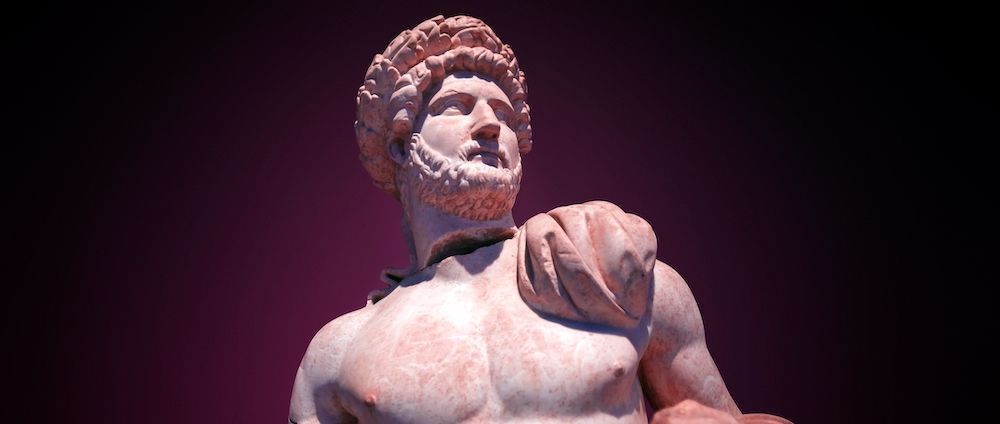
Spain | Pantheon | Tivoli
Life: AD 76-138. Emperor: AD 117-138
Hadrian is famous for his travels. After being three years in Rome, in AD 121 he set forth on a tour across the Roman Empire to visit and control the vast frontiers established by his predecessors.
He started his trip visiting the western provinces, which occupied current France, Germany, Britain, and the Iberian Peninsula. After that, Hadrian traveled to the east and subsequently returned to Rome in AD 125. In AD 128, he continued his ‘Empire-tour’ visiting current North Africa, Greece, Turkey, the Aegean territories, and the Balkans, in the east.
With intermittent stops in Rome, Hadrian traveled across the majority of provinces. By doing this, he brought the presence of the emperor to territories away from the capital. Cities all over the Empire build new arches, buildings, and structures to commemorate his visit. And he minted new coin designs commemorating his visits to provinces too!
Major Works
Hadrian was passionate about art, philosophy, and architecture. Like any other emperor, he left his imprints in Rome’s cityscape… and nowadays you can visit some buildings. In circa AD 126 he rebuilt the Pantheon, which is one of the few Roman monumental buildings fully preserved.
It could have been designed by Apollodorus of Damascus, an architect active during the reign of Trajan, although no direct references exist. In AD 609, the Pantheon became the Basilica of St. Mary and the Martyrs which is likely why it exists today. Converting pagan temples to churches was the best way to stop Christians from destroying them.
In addition, another monument built by Hadrian was the Temple of Venus and Roma, just in front of the Coliseum.
Hadrian’s influence reached the farthest points on the edge of the Empire. He built the monumental Hadrian’s Wall (Vallum Hadriani in Latin) to protect the empire from the Picts in about six years.
Hadrian’s villa, in Tivoli, is his most personal and eclectic project. The palace complex was like a small city that showcased the architectural styles he discovered during his travels. Hadrian’s villa included baths, places, a theatre, temples, gardens, dining rooms, pools… and even an astronomical observatory.
After his death, Hadrian’s decided to rest in a monumental mausoleum he built in Rome which is now Castel Sant’Angelo. You can visit its remains in the current Castel Sant’Angelo, which became a fortress in the Middle Ages.
4. ANTONINUS PIUS, the Wise
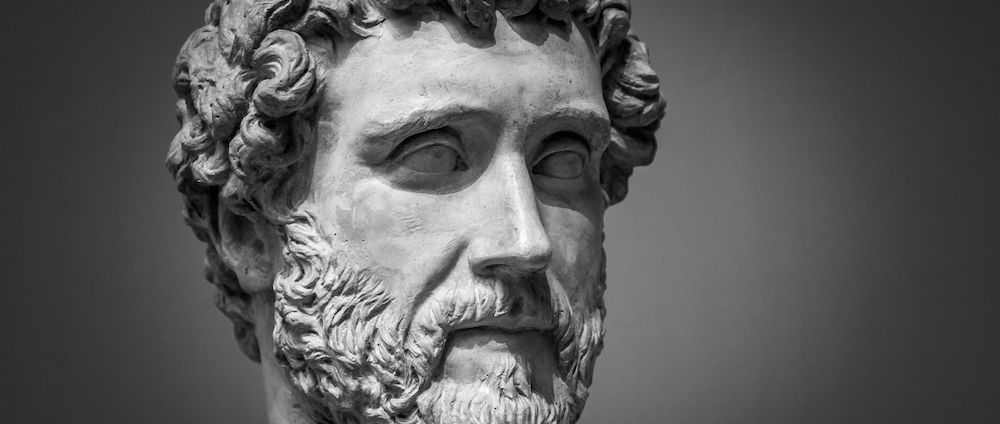
Antonine Wall | Hadrianeum | Faustina
Life: AD 86-161. Emperor: AD 138-161
Antoninus Pius is famous for the kindness and wisdom that characterized his not-so-brief reign. Amanda Claridges notes how he was one of the dullest figures in Roman political history. In fact, his reign experienced stability and peace resulting from his actions.
Xaver Bossart and Johann Jacob Müller described him as a good administrator of the Empire’s finances and very respectful of the official religion. Nevertheless, he was tolerant of some oriental cults such as the one to Magna Mater. Archaeology has unveiled the prosperity of his reign, characterized by the embellishment of luxury villas and the creations of gardens.
Major Works
Claridge highlights the scarcity of building projects Antoninus Pius carried out ex Novo. He also restored or finished some building projects, such as Hadrian’s mausoleum in AD 139. After Hadrian’s death in AD 138, he built a temple to the deceased deified emperor in AD 145 which served as the modern Italian stock market for years. Now, it is an amazing setting to grab a drink in Rome.
In addition, Antoninus Pius built a temple for his deceased and deified wife Faustina in AD 140. Located along the upper Via Sacra in the forum, its monumental façade is part of the church of S. Lorenzo in Miranda.
Outside Rome, Antoninus Pius is famous for the Antonine Wall which is a Roman frontier in Britain around AD 142. This wall was located beyond the former Hadrian’s wall, extending the frontiers of the empire to the north. However, it was only in use until AD 160, when the troops returned to the former Hadrian’s Wall due to the territorial instability.
5. MARCUS AURELIUS, the Philosopher
Second Century | Philosopher | Meditations
Life: AD 121-180. Emperor: AD 161-180
Marcus Aurelius is famous for his Stoic philosophy and the relative stability that characterized his reign. He reigned alongside his adoptive brother, Lucius Verus. After his death in AD 180, the relative peace characterizing the Empire since Augustus’ reign ended.
He fought the Parthians (AD 161-166) and the Germanic Tribes (AD 166-180). Finally, he died in AD 180 while being on a campaign in the Danube. Marcus Aurelius is known to have practiced legislation rigorously. Among his administrative reforms, the revaluation of the denarius stands out.
However, one of the most known challenges he faces as emperor was the outbreak of the Antonine Plague. Scholars locate the origin of this ‘ancient pandemic’ in Mesopotamia around AD 165, at the end of the campaign against the Parthians. Scholars believe this plague was smallpox
Major Works
Like many other emperors, Marcus Aurelius left his imprints in the city of Rome, although not through great buildings, as Amanda Claridge mentions.
Close to Via del Corso, you can find the Column of Marcus Aurelius, dated between AD 180-193. The column, inspired by Trajan’s column, depicts his military campaigns and victory over the Sarmatians and Germanic tribes. Construction was actually carried out by Commodus after the reign of Marcus Aurelius.
One of the most impressive works associated with Marcus Aurelius is his equestrian sculpture. The Capitoline Museum houses the original statue, whilst the one in Piazza del Campidoglio is a copy. The main reason the statue still exists today, rather than being destroyed by Christians, is because they thought it to be Constantine the Great who legalized Christianity.
Marcus Aurelius is famous for his Meditations. He wrote them between 170-180 AD and the real title of his writing remains unknown. He wrote them in Greek, in an style that invites the reader to meditate and sefl-reflect. If you want to have a masterclass on stoicism and philosophy, his writing are a must.
